I ran across an article several months ago that immediately captured my attention. It was a photograph that sent chills down my spine. I said to myself, “Now that’s a very powerful image.”
I thought about the story behind the photograph and decided to write a blog about powerful and iconic images from World War II. Unfortunately, we can only include twenty-five photographs in this blog. However, there are hundreds if not thousands of other photographs that would fit into the theme of this blog. If interested, you can check out various web sites listed below to view some of the other photographs we did not include.
Please be warned that some of the images included in this blog are very disturbing.
We begin our photographic journey with the Hanukkah menorah in the window. It is the image that inspired me to write this blog.
Did You Know?
Did you know that nearly all forty of the original Washington D.C. boundary stones are hidden in plain sight? The capital city of the United States was originally a ten-mile by ten-mile diamond shape. These stones marked the boundaries of the city, and they are the oldest federally placed monuments in the United States.
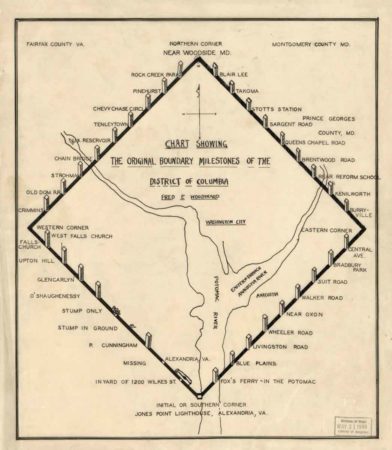
Andrew Ellicott was hired to chart out the new city, but the surveyor needed an assistant to read the stars to ensure the markers were placed accurately. Benjamin Banneker, an African American, was recommended to Ellicott. He questioned the competence of a Black man who had no formal schooling or scientific training. Faced with no alternatives, Ellicott hired the amateur astronomer to work alongside him. For six nights, Banneker lay on his back to record the stars and with those calculations, the first marker stone was placed at Jones Point. (You can see the stone through a window in the seawall of the 19th-century Jones Point Lighthouse.)
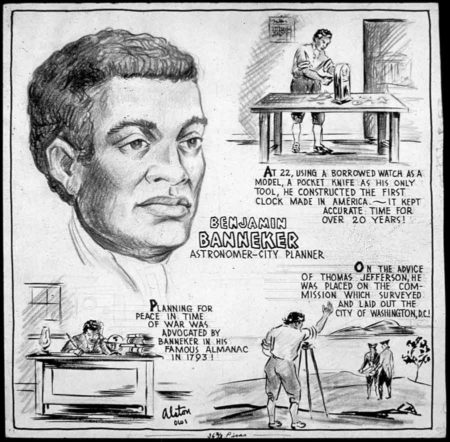
The stones are one foot square and three feet high. They were placed one mile apart and each is numbered according to its quadrant and location. Each side bears the inscription of either “Virginia” or “Maryland” depending on its border state. Other information inscribed on the sandstone markers were the words “Jurisdiction of the United States,” a mile number, the date the stone was erected (either 1791 or 1792), and a magnetic compass variance for the stone’s location. Thirty-six stones remain in their original place (some in severe deterioration as sandstone is not the best material for posterity) while three are replicas and one is represented by a simple plaque.
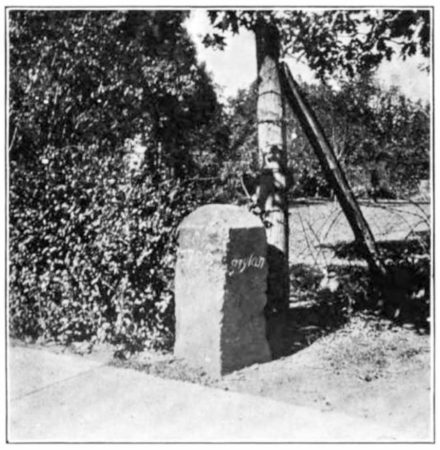
Thomas Jefferson was secretary of state at the time, and he went on record as saying he did not believe Black and enslaved people were of the same standards as White people in terms of brains and physical abilities. Clearly, Jefferson had never met Mr. Banneker.
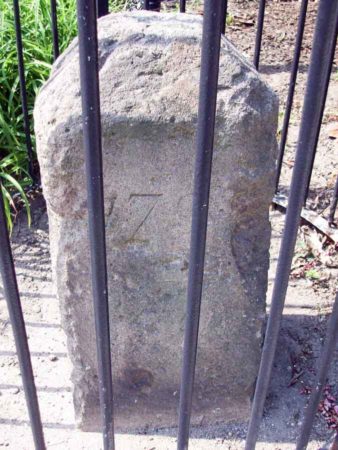
The Hanukkah Menorah
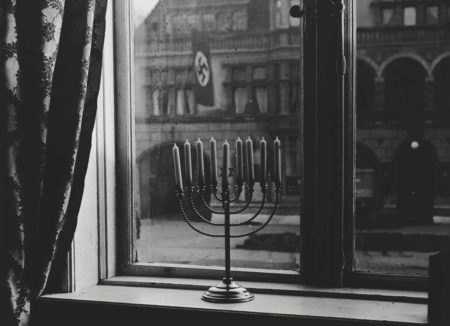
One day in 1931, Rachel (a.k.a. Rahel) Posner (1900−1982) took a picture of her family’s Hanukkah menorah sitting on a ledge and framed by the window in their Kiel, Germany house. Looking at the developed photograph, Rachel could see the chilling image of a large Nazi swastika banner hanging across the street. She wrote on the back of the photograph the following:
Chanukah 5692
(1932)
“Death to Judah”
So the flag says
“Judah lives forever”
So the light answers.
Three months after Hitler took power (1933), Rachel, her husband Arthur (1890−1962), and their three children left Kiel and made their way to Eretz, Israel in 1934. They took the menorah and today, it is on permanent loan to Yad Vashem with the condition that the family is allowed to retrieve it once a year to be used for eight days.
(Image accreditation no 1 below)
Assault on Omaha Beach
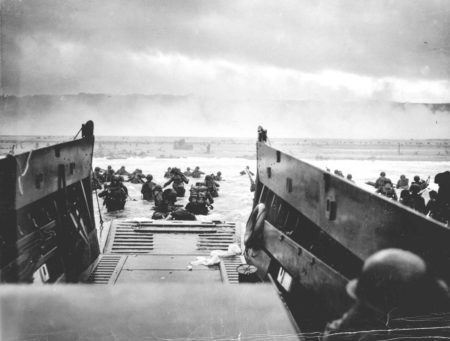
Put yourself in the shoes (or rather boots) of a nineteen-year-old soldier about to wade into the water at approximately 6:30 on the morning of 6 June 1944. This would have been your view. Imagine the last words from your commanding officer including, “Some of you won’t be going home.” You know the Germans have built the Atlantic Wall; the coastal defense system they consider impenetrable. As soon as the landing door of the LST drops, you see German artillery exploding in the water just in front of the LST. It is three hundred yards to the bluffs and the chance of being hit by a German bullet is very high. As a soldier of the “Big Red One,” you are one of about 156,000 Allied soldiers hitting the Normandy beaches that morning. By 10:00 a.m., a key German artillery gun is put out of action and Omaha Beach is secured. Your regiment suffered thirty percent casualties in the first hour alone. The total cost in human life that day was about 4,414 Allied deaths (2,501 Americans).
(Image accreditation no 2 below)
Nagasaki Atomic Cloud
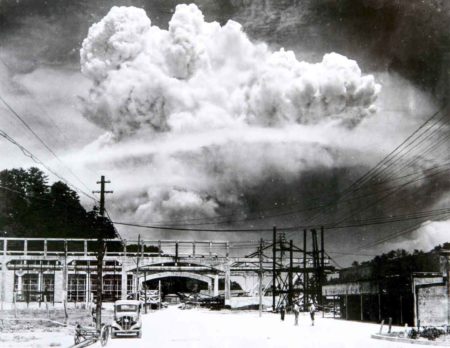
After the atomic bomb was dropped on Hiroshima, there was almost complete agreement that it was a necessary act of war to protect the lives of more than one million American lives (i.e., the anticipated invasion force). However, President Truman’s decision to drop the bomb on Nagasaki three days later (9 August 1945), killing more than 100,000 civilians, generated controversy over whether we should have proceeded with dropping the second bomb. This controversy continues today. After Hiroshima, the Japanese refused to surrender. After Nagasaki, the Emperor gave the order to surrender.
(Image accreditation no 3 below)
Normandy Dead
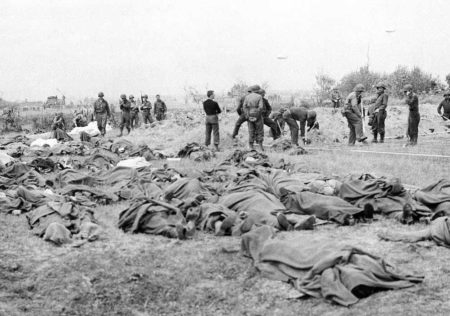
About 4,414 Allied soldiers were killed on D-Day. These are the remains of some of the American soldiers who died on the beaches. Most will be eventually buried at the Normandy American Cemetery in Colleville-sur-Mer, France. If you have never been to the American Cemetery in Normandy, you must visit it at least once in your lifetime.
(Image accreditation no 4 below)
Beheading of Sgt. Siffleet
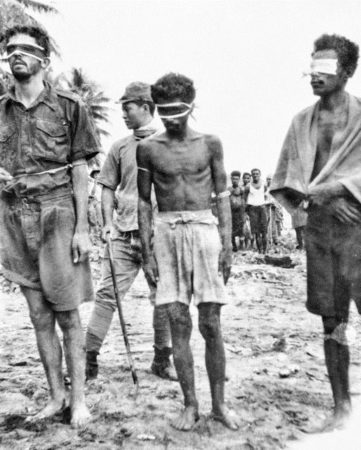
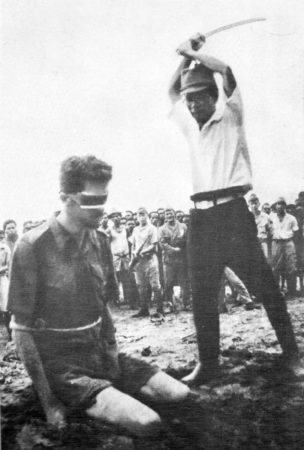
Sgt. Leonard Siffleet (1916−1943), an Australian commando, and two other men were on a reconnaissance mission behind Japanese lines when they were captured by New Guinea natives and turned over to the Japanese. They were interrogated, tortured, and executed by beheading. The commander of Japanese naval forces at Aitape, Adm. Michiaki Kamada (1890−1947), ordered their execution. The executioner, officer Yasuno Chikao, had one of his men take these photographs moments before the executions. The photos were found in 1944 on the body of a dead Japanese soldier. Kamada was tried and executed for war crimes. Chikao either did not survive the war or returned to Japan after serving a ten-year sentence. (There seems to be differing opinions.)
(Image accreditations no 5 and no 20 below)
KZ Auschwitz II-Birkenau
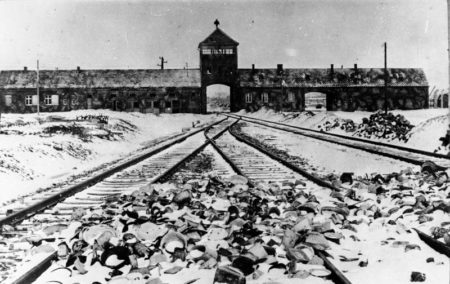
This is the iconic photograph of the rail entrance to the extermination camp, KZ Auschwitz II-Birkenau. On the other side was a ramp next to the tracks and a short distance away, the gas chambers and crematoriums. The convoys stopped and the human cargo was unloaded where the sorting process began. Each convoy carried about one thousand Jews. Once sorted, one group (principally women and children) went to their deaths in the gas chambers within an hour of arriving. The other group was allowed to live for the time being.
(Image accreditation no 6 below)
Dresden Bombing
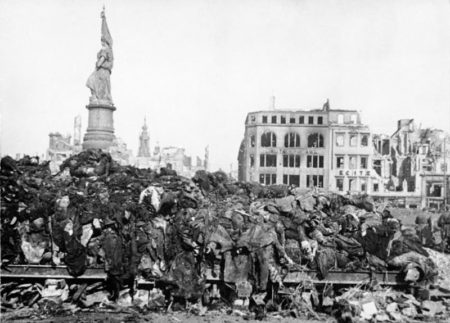
During four Allied bombing raids between 13 and 15 February 1945, almost 1,300 heavy bombers dropped enough bombs and incendiary devices on Dresden to destroy most of the city and kill about 25,000 civilians. While the bombs took their toll, it was the ensuing firestorm that caused the most damage and death. While defended by the United States and England, postwar discussions of the bombings have centered on whether this attack was justified. Click here to read the blog, Dresden Brick Ladies.
(Image accreditation no 7 below)
Smoke
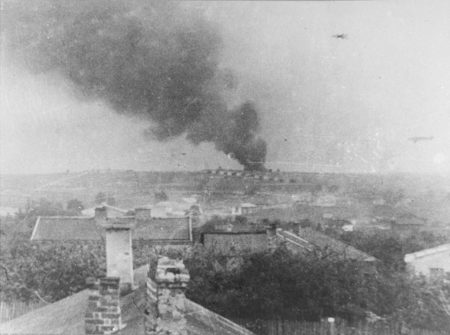
From the rooftop of a building in the village of Dziesiata, Poland, smoke can be seen coming from KZ Majdanek, one of the Nazis’ six extermination camps (i.e., built solely for the wholesale murder of Jewish deportees and prisoners). The smoke is from a burning pyre of corpses in the camp.
(Image accreditation no 8 below)
Dachau Death Train
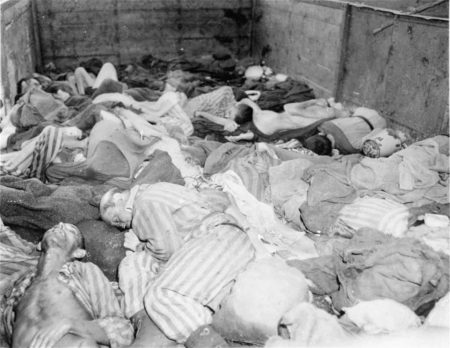
On 7 April 1945, more than fifty freight/cattle cars left KZ Buchenwald. The cargo, about four thousand inmates, was being transported to KZ Dachau. For two weeks, the train traveled with the passengers given only one day’s worth of rations for the entire trip and no water. The convoy had to stop on 19 April at Nammering due to the tracks ahead having been destroyed by Allied bombing. On the afternoon of 28 April, the train finally arrived at its destination but only a quarter of the inmates survived the trip. The SS left the dead and dying behind in the freight cars. The next day, American troops liberated the concentration camp and found the train.
(Image accreditation no 9 below)
The Épuration
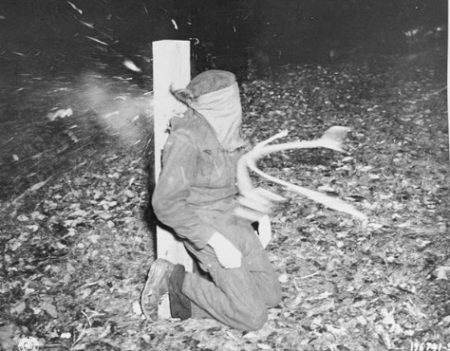
L’épuration sauvage (unofficial purge) and l’épuration légale (legal purge) took place after the liberation of France. Initially, the revenge against real or suspected collaborationists (collabos) was swift and brutal, often without any trial. It wasn’t until Gen. de Gaulle established his government that the lawless persecution and punishment of collabos ceased. It was followed by de Gaulle’s orders for legal proceedings against those suspected of collaborating with the Germans. This image was taken at the exact moment the bullets from the firing squad ripped through the body of this French collabo. Since the photo was taken in late November 1944, I suspect he was afforded a trial, something the Germans or French gangs such as Bonny-Lafont or the Milice never offered their victims.
(Image accreditation no 10 below)
Postmortem Experience
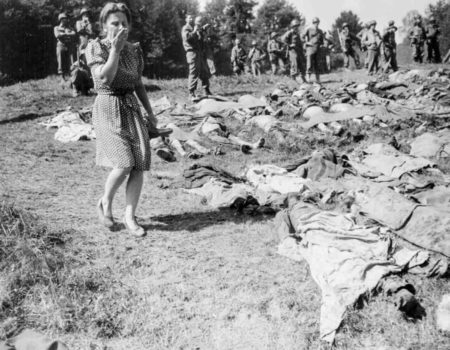
After the Allies began to liberate the concentration camps, Gen. Eisenhower and his senior officers visited KZ Ohrdruf Nord, a sub-camp of KZ Buchenwald, on 12 April 1945. After witnessing the horrors of the camp, Eisenhower gave two orders. The first was to bring in army photographers to visually document the atrocities. The general knew that as time went on, people would forget and perhaps deny these war crimes ever existed. Second, he ordered local citizens to visit the camps and see for themselves the aftermath of the crimes against humanity that Hitler and the SS perpetrated. After the war, almost every German told their interrogators that they knew nothing of the extermination camps or the fate of the Jews. It is highly likely they must have been “mistaken” and it is inconceivable that people living in nearby villages didn’t know the truth.
(Image accreditation no 11 below)
Head Shaving
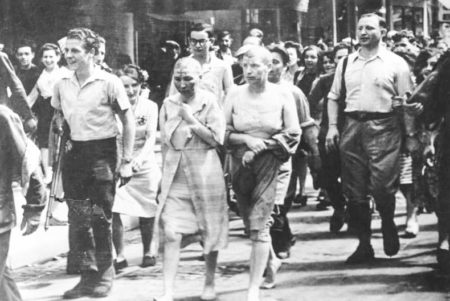
Immediately following the liberation, the French went hunting for collaborationists. The first group wasn’t too hard to identify. These were the women who took German boyfriends or lived with a German soldier. Typically, a woman’s husband was a French soldier who had been captured by the Germans and spent four years in a German POW camp or as forced labor in Germany. Other women had babies or young children and they used their German boyfriend as a way to feed their kids. Head shaving and being paraded around town was the usual punishment. However, there were more severe consequences for some women. Fortunately, after Gen. de Gaulle took control, much of the revenge-based activity was discontinued.
(Image accreditation no 12 below)
KZ Buchenwald Ovens
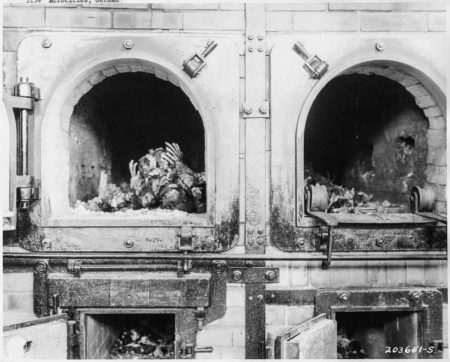
When U.S. Maj. Gen. Robert W. Grow’s 6th Armored Division liberated KZ Buchenwald on the afternoon of 11 April 1945, his men found the crematorium with its six ovens. The ovens were still warm and filled with human remains. These ovens, known as “triple muffle Topf,” are the same type used at KZ Auschwitz II-Birkenau.
(Image accreditation no 13 below)
Prosthesis
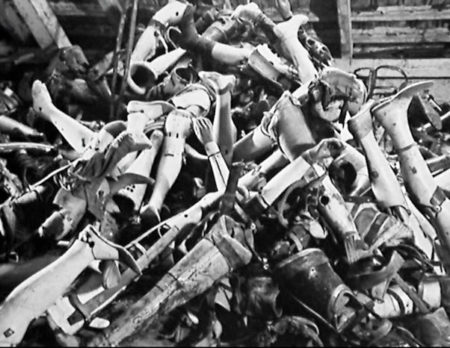
Upon liberating KZ Auschwitz II-Birkenau on 27 January 1945, the Soviet army encountered a multitude of shocking images. In one section of the camp near the crematoriums were warehouses filled with the personal effects of the victims murdered by the Nazis. Today, the Auschwitz-Birkenau Memorial and Museum maintains an extensive collection of personal artifacts. These include 470 prostheses and orthoses, 246 prayer shawls, twelve thousand kitchen utensils, 3,800 suitcases, and 52 cubic yards of shoes.
(Image accreditation no 14 below)
Manzanar Relocation Center
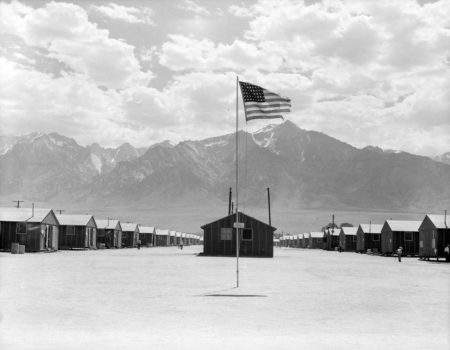
When I came across this photograph, I knew it had to be included in my little collection of powerful images. Most of us are familiar with the story behind the ten relocation centers where more than 120,000 Japanese American citizens were incarcerated between March 1942 and November 1945. Manzanar was one of the smallest camps holding up to ten thousand men, women, and children. Many of the photos I looked at were very similar to this one with one exception: this photograph includes the American flag flying in the courtyard between the barracks. Looking through a lens called “hindsight,” it seemed to me to be an allegorical image that is not too flattering.
(Image accreditation no 15 below)
Convoy Train Liberation
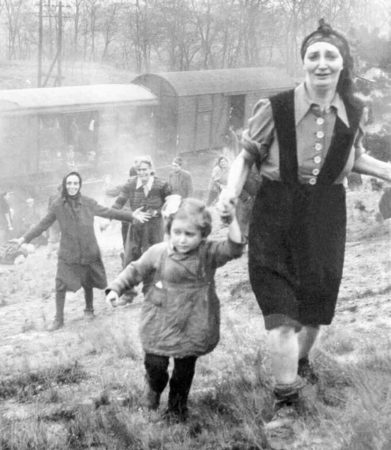
I’ll bet most of you have never seen this photograph before. It’s no secret that toward the end of the war, Himmler gave the order that all concentration camp inmates were to be killed. As the Soviet army marched westward and began approaching camps, the SS forced inmates into “death” marches out of the camps. Three convoy trains loaded with Jews from Poland, Russia, and other eastern European countries left KZ Bergen-Belsen on 10 April. The intent was to deliver them to an extermination camp where they would be murdered. This train carried 2,500 inmates and traveled east until it got as far as the Elbe River. Due to the advancing Soviet army, the train had to turn around. However, after reversing direction, the train arrived in Farsleben, Germany on 13 April where it stopped because of the advancing American army from the west. The train engineers received orders to turn around and go back to the Elbe and drive the train off the bridge. The engineers refused those orders after realizing they would be killed and right about that time, the 743rd Tank Battalion showed up. This photograph was taken at the moment the passengers realized they were free.
(Image accreditation no 16 below)
The Oradour-Sur-Glane Massacre
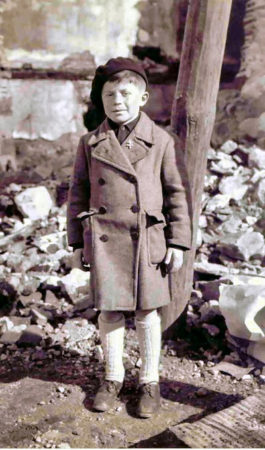
One of the many atrocities committed by the SS was the massacre at the village of Oradour-sur-Glane, France. The Der Führer regiment of the SS Das Reich division was relocated to France from the eastern front in early 1944. The regiment was led by SS-Brigadeführer Sylvester Stadler (1910−1995) and one of his commanders was SS-Sturmbannführer Adolf Diekmann (1914−1944). On 10 June 1944 in retaliation for resistance activity in the area, the Der Führer regiment arrived in Oradour-sur-Glane where Diekmann ordered the murder of everyone in the village. The final toll was 191 men, 247 women, and 205 children for a total of 643 people murdered. (The majority were locked in a church that the SS set on fire.) Only five men, one woman, and two children survived the massacre. Seven-year-old Roger Godfrin (1936−2001) was one of the two children who survived. Gen. de Gaulle ordered the village to remain exactly as it was left after the massacre. Today the remains of the village are a French national memorial.
(Image accreditation no 17 below)
Selection on the Ramp
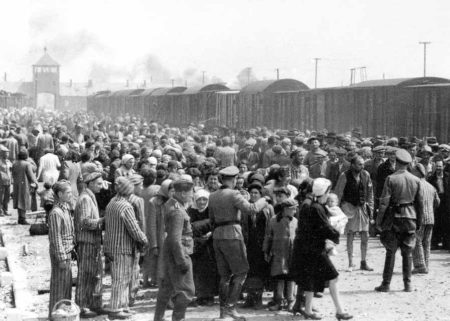
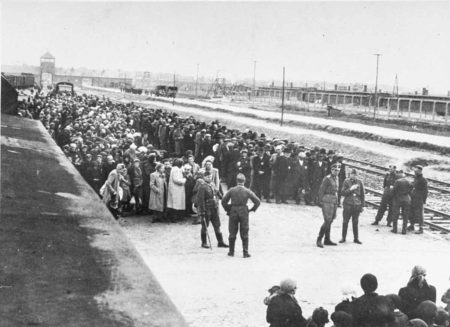
Jews from Hungary arrive at KZ Auschwitz II-Birkenau, one of the Nazis’ six extermination camps, in May 1944. In the top photo, they have just disembarked from the convoy train in the background. The photograph on the bottom shows the men lined up on the right and the women and children on the left. They are waiting for the selection process to begin. The majority of them will be dead within one hour.
(Image accreditation no 18 and no 19 below)
The Warsaw Ghetto Uprising
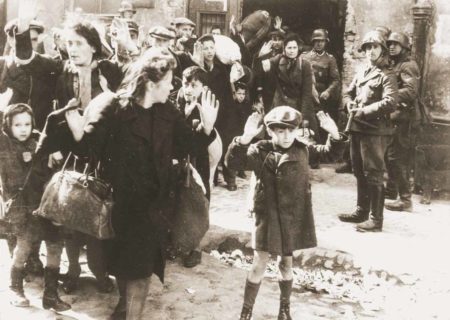
This is considered by historians to be one of the most iconic images of the war. It is a group of Jews exiting their bunkers and surrendering to German guards during the Warsaw Ghetto uprising between 19 April and 16 May 1943. After the summer of 1942 when a quarter million Jews were deported from the ghetto to the KZ Treblinka death camp, the remaining inhabitants of the Warsaw Ghetto began to stockpile weapons and build underground bunkers. The uprising was the largest single act of resistance by Jews during the war. After one month of fighting, about 13,000 Jews were dead. SS-Brigadeführer Jürgen Stroop (1895−1952) ordered the burning of the ghetto as well as the deportation of the survivors to KZ Treblinka and KZ Majdanek. The image is famous for the young boy surrendering to one of the guards, SS-Rottenführer (corporal) Josef Blösche (1912−1969). (Click here to read the blog, Nazi Frankenstein). The identity of the boy has never been confirmed but there are three possibilities: Artur Dab Siemiatek, Levi Zelinwarger, or Tsvi Nussbaum.
(Image accreditation no 21 below)
Only Eighteen
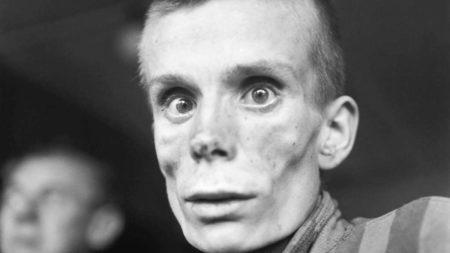
The day after KZ Dachau was liberated, this photograph was taken by Eric Schwab. The camp prisoner is a hollow-eyed 18-year-old Russian Jewish boy. He is suffering from malnutrition and dysentery. His identity and fate remain a mystery.
(Image accreditation no 22 below)
The Weeping Frenchman
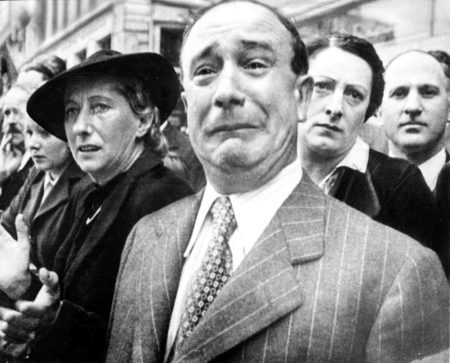
This ranks right up there with iconic war photographs, especially those of occupied France. The weeping Frenchman is usually presented as someone standing on the av. des Champs-Élysées in Paris on 14 June 1940 as the Germans march into the city. It has represented the sadness and despair of the French as they watch their city being occupied. Unfortunately, the source is not true. The image is a still photograph from the footage of a short newsreel shot in Marseille, France (at about the 29 second point) on 20 February 1941. M. Jerôme Barzetti and the crowd are watching a parade of French Regimental banners leaving France for safe keeping in Algeria. The flags and banners were returned to Marseille after the liberation. Just goes to prove you can never trust a caption or date (except mine, haha)..
(Image accreditation no 23 below)
Liberation of KZ Bergen-Belsen
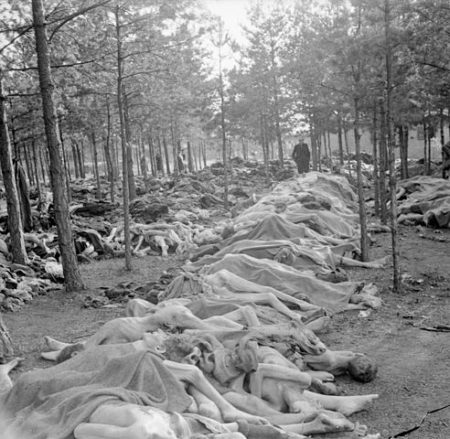
This is one of the horrific sights waiting for British troops at KZ Bergen-Belsen when they liberated the camp on 15 April 1945.
(Image accreditation no 24 below)
The Sudetenland Tragedy
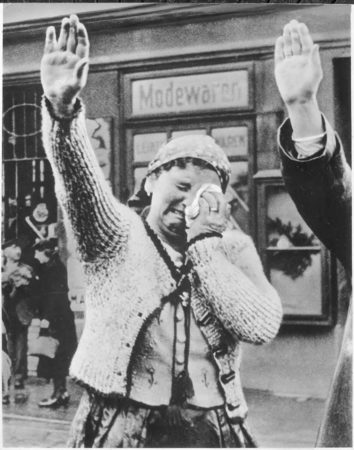
I thought the dichotomy of this image was very interesting. The caption says this woman was visibly distressed over Hitler’s victory in annexing the Sudetenland yet here she is raising her hand in the “Hitler salute.” The Sudetenland was the historical German name for the area consisting of the northern, southern, and western parts of Czechoslovakia. As of 1921, there were 3,123,000 ethnic Germans living in the Sudetenland, or 23% of Czechoslovakia’s total population. Was she a supporter of Hitler and the Nazis or was she crying for some other reason? My understanding is that the vast majority of Germans and those in the annexed lands (e.g., Sudetenland, Austria, etc.) supported Hitler during the pre-war years.
(Image accreditation no 25 below)
Heartsick
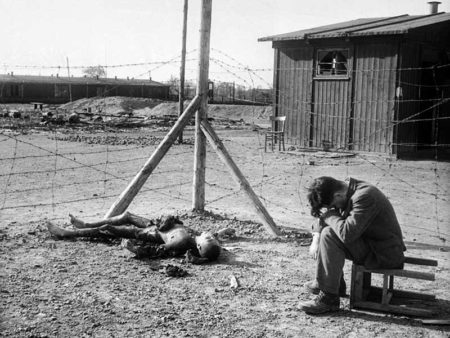
Heartsick, brokenhearted, depressed, despondent, inconsolable, mournful, or sorrowful. You can pick any or all of these words to describe how this young man feels at this very moment. Eric Schwab took this photograph soon after the liberation of KZ Leipzig-Thekla concentration camp, a sub-camp of KZ Buchenwald. The SS guards rounded up inmates at the camp and forced them into buildings that were then locked and set on fire. Is this man with his head in his hands in front of a burned corpse one of the liberating soldiers or one of the people from the local village forced to view the aftermath of the Nazis?
(Image accreditation no 26 below)
Final Word
Yes, some of these photos are disturbing. However, there are thousands more that will disturb you to an even greater degree.
NEVER FORGET!
Next Blog: “Audrey Hepburn and Queen Wilhelmina”
Correspondence and Commentary Policy
We welcome everyone to contact us either directly or through the individual blogs. Sandy and I review every piece of correspondence before it is approved to be published on the blog site. Our policy is to accept and publish comments that do not project hate, political, religious stances, or an attempt to solicit business (yeah, believe it or not, we do get that kind of stuff). Like many bloggers, we receive quite a bit of what is considered “Spam.” Those e-mails are immediately rejected without discussion.
Our blogs are written to inform our readers about history. We want to ensure discussions are kept within the boundary of historical facts and context without personal bias or prejudice.
We average about one e-mail every two days from our readers. We appreciate all communication because in many cases, it has led to friendships around the world.
★ Read and Learn More About Today’s Topic ★
These are links to various sites I thought you might find interesting and where you can find iconic and powerful historical images.
Powerful World War 2 Photos. Click here.
Reuters 75 iconic photos from World War Two. Click here.
National Archives Military Records WWII Photos. Click here.
Ten Iconic Images WWII. Click here.
Rare Historical Photos. Click here.
Imperial War Museum. Click here.
Life World War II Photos. Click here.
Image Accreditations
- Photo by Rachel Posner (c. December 1931). Nava Gilo/Yad Vashem.
- Photo by Chief Photographer’s Mate Robert F. Sargent (6 June 1944). Naval Historical Center. Photo no. 26-G- 2343/Vendor #93. PD-U.S. Government. Wikimedia Commons.
- Photo by Hiromichi Matsuda (9 August 1945). Hiromichi Matsuda/Nagasaki Atomic Bomb Museum. PD-Japan Public Domain.
- Photo by anonymous (8 June 1944). PD-U.S. Government.
- Photo by anonymous (24 October 1943). PD-Japan Public Domain. Wikimedia Commons.
- Photo by Stanislaw Mucha (c. January 1945). Bundesarchiv, B 285 Bild-04413/Stanislaw Mucha/CC-BY-SA 3.0. PD-CCA-Share Alike 3.0 Germany. Wikimedia Commons.
- Photo by Hahn (c. February 1945). Bundesarchiv, Bild 183-08778-0001/Hahn/CC-BY-SA 3.0. PD-CCA-Share Alike 3.0 Germany. Wikimedia Commons.
- Photo by anonymous (c. Ocotber 1943). United States Holocaust Memorial Museum Photo no. 83854, courtesy of Państwowe Muzeum na Majdanku (The State Museum of Majdanek).
- Photo by Eric Schwab (29 April-1 May 1945). United States Holocaust Memorial Museum Photo no. 85555. PD-Author’s release. Wikimedia Commons.
- Photo by anonymous (21 November 1944). United States Holocaust Memorial Museum Photo no. 81870. PD-Author’s release. Wikimedia Commons.
- Photo by Cpl. Edward Belfer (17 May 1945). National Archives and Records Administration. PD-U.S. Government. Wikimedia Commons.
- Photo by anonymous (c. August 1944). German Federal Archives. PD-CCA-Share Alike 3.0 Unported. Wikimedia Commons.
- Photo by Eric Schwab (c. April 1945). National Archives and Records Administration. PD-U.S. Government. Wikimedia Commons.
- Photo by anonymous (c. January 1945). Agence France-Presse (AFP).
- Photo by Dorothea Lange (3 July 1942). National Archives at College Park. PD-U.S. Government. Wikimedia Commons.
- Photo by Clarence L. Benjamin (c. April 1945). PD-U.S. Government. Wikimedia Commons.
- Photo by anonymous (c. 1945). Agence France-Presse (AFP).
- Photographers are thought to be either SS officers Bernhardt Walter or Ernst Hofmann. United States Holocaust Memorial Museum Photo no. 77319. PD-No copyright notice. Wikimedia Commons.
- Photographers are thought to be either SS officers Bernhardt Walter or Ernst Hofmann. Yad Vashem. PD-Expired copyright. Wikimedia Commons.
- Photo by anonymous (24 October 1943). PD-Australian Public Domain. Wikimedia Commons.
- Original photograph found in the Stroop Report. German Federal Archives. PD-U.S. Government. Wikipedia Commons.
- Photo by Eric Schwab (1 May 1945). Agence France-Presse (AFP).
- Photo by anonymous (15 September 1940). Still image taken from footage of a short newsreel (at 29 seconds).
- Photo by Sgt. Oakes (c. mid-April 1945). War Office Second World War Official Collection. PD-U.K. Public Domain. Wikimedia Commons.
- The tragedy of the Sudeten woman Photo by anonymous (c. 1938). National Archives at College Park. Expired copyright. Wikimedia Commons.
- Photo by Eric Schwab (c. mid-April 1945). Agence France-Presse (AFP).
Disclaimer:
There may be a chance that after we publish this particular blog, the video links associated with the blog are no longer accessible. We have no control over this. Many times, whoever posts the video has done so without the consent of the video’s owner. In some cases, it is likely that the content is deemed unsuitable by YouTube. We apologize if you have tried to access the link and you don’t get the expected results. Same goes for internet links.
What’s New With Sandy and Stew?
Sandy and I are packing our bags for a one-week cruise through the Caribbean. We are hosting our daughter, her husband, and their two boys. We’ve never been on any of Royal Caribbean’s largest ships, but the Harmony OTS looks like one gigantic amusement park. Considering how expensive Disney Cruises are, this seems to be the best alternative for a five- and ten-year-old. We like leaving from the east coast of Florida because it means we can drive to Miami and won’t have to hassle with an airplane flight (or multiple flights). This cruise will be different for us in one major way: we won’t be doing any work during our seven days on-board. Normally, it seems I take half my library with us as we work on the books and blogs during the sea days. This time, I won’t be loaded down other than throwing the grandkids in the pool.
Hey, I just want to remind all of you about Shepherd.com. It’s a great site to find books you might be interested in reading. You owe it to yourself to check it out. Click here to visit www.shepherd.com.
Thank you to all of you who subscribe to our bi-weekly blogs. It seems there isn’t a day that goes by where we don’t increase our readership. Please let your history buff friends and family members know about our blog site and blogs.
Someone Is Commenting On Our Blogs
I’d like to thank Fabrice D. for assisting me with some research confirming certain facts I need for the second and third volumes of Where Did They Put the Gestapo Headquarters? As a nephew of Armel Guerne (1911−1980), second-in-command of the SOE Prosper circuit under Francis Suttill, Fabrice is a member of the famous Libre Résistance organization. I sent Fabrice a copy of the first volume (via his son, Simon) and asked him to let me know if and when he received it. Here is the photo of Fabrice proving he got the book (Simon, thank you for the photo). Thanks, Fabrice, for all your help and I hope you enjoy the book!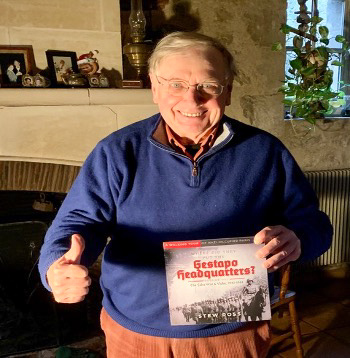
If there is a topic you’d like to see a blog written about, please don’t hesitate to contact me. I love hearing from you so keep those comments coming.
Do you enjoy reading? Do you have a hard time finding the right book in the genre you enjoy? Well, Ben at Shepherd.com has come up with an amazing way to find that book.
Shepherd highlights an author (like me) and one of their books. The author is required to review five books in the same genre. So, if a reader is interested say in cooking, they can drill down and find specific books about cooking that have been reviewed by authors in that category. Very simple.
If you like to read, I highly recommend you visit Shepherd.com. If you do, please let me know what you think and I will forward Ben any suggestions or comments you might have.
Click here to visit Shepherd’s website.
Click the books to visit Stew’s bookshelf.
Share This:
Follow Stew:
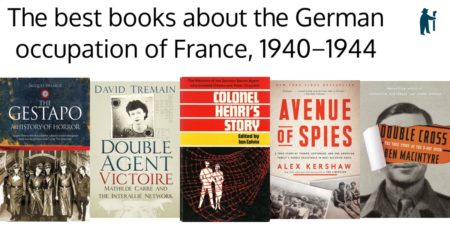
Find Stew’s books on Amazon and Apple Books.
Please note that we do not and will not take compensation from individuals or companies mentioned or promoted in the blogs.
 Walks Through History
Walks Through History
Copyright © 2023 Stew Ross



Sobering and important to remember. It’s hard to imagine there are people who still claim that the Holocaust did not happen. However, it’s not surprising these days. Thanks, Stew.
Hey Greg; Always a pleasure to hear from you. I only wish I could have injected more images but space limitations prevented me from doing so. The blog was very popular and I suspect we will do a “Powerful Images, Part II” at some point. STEW